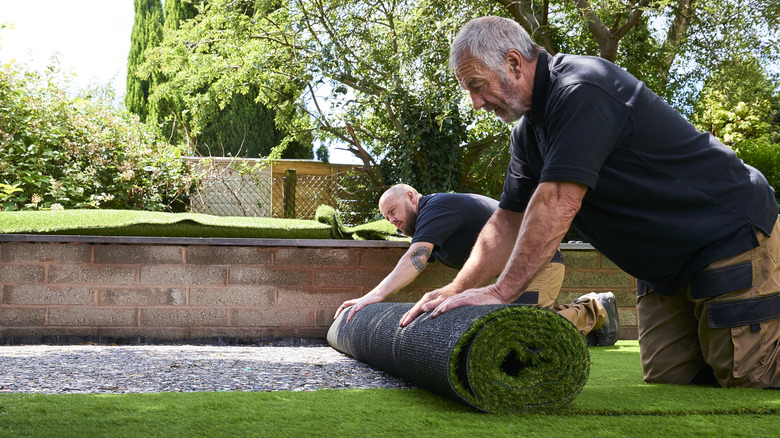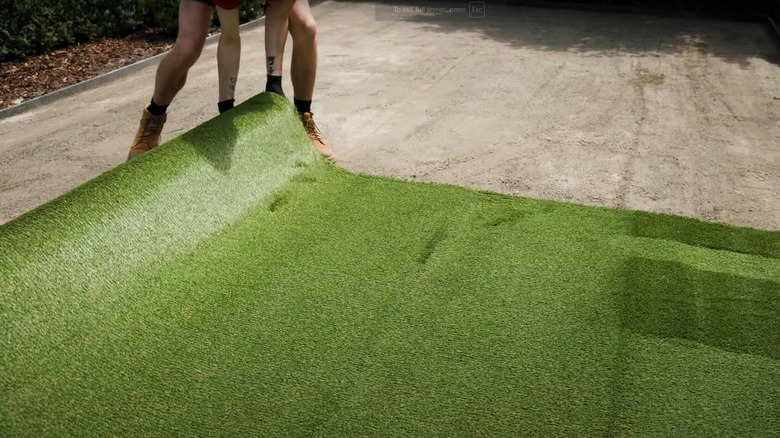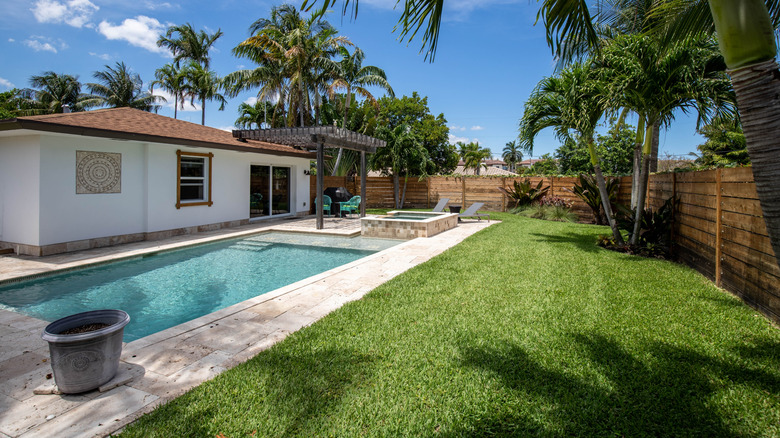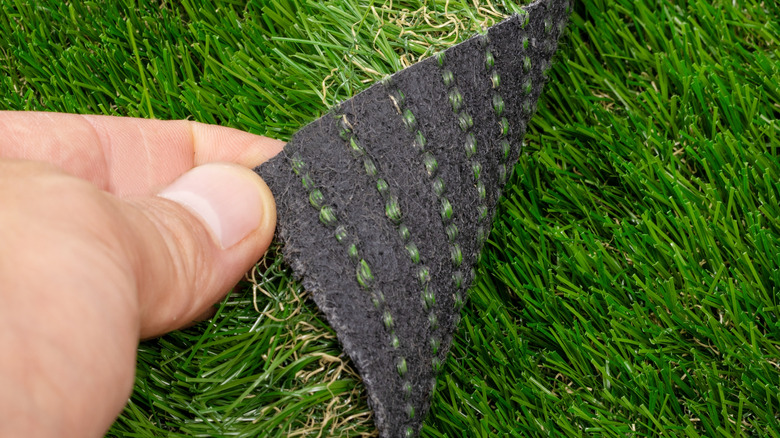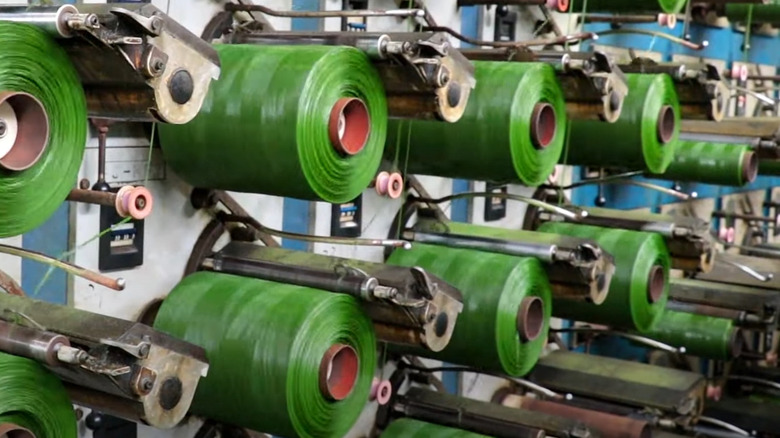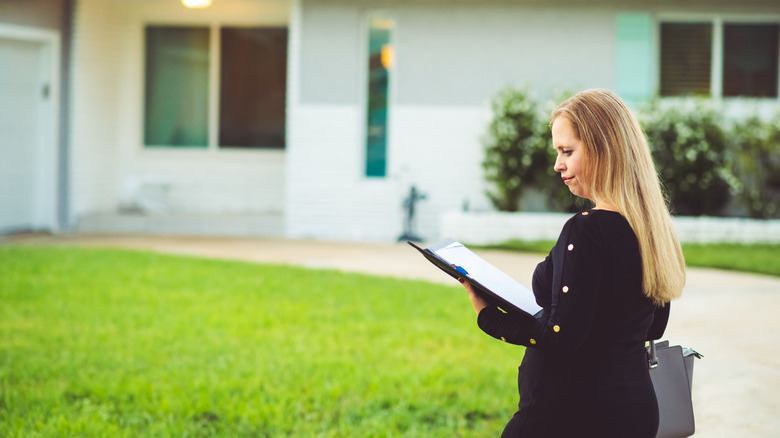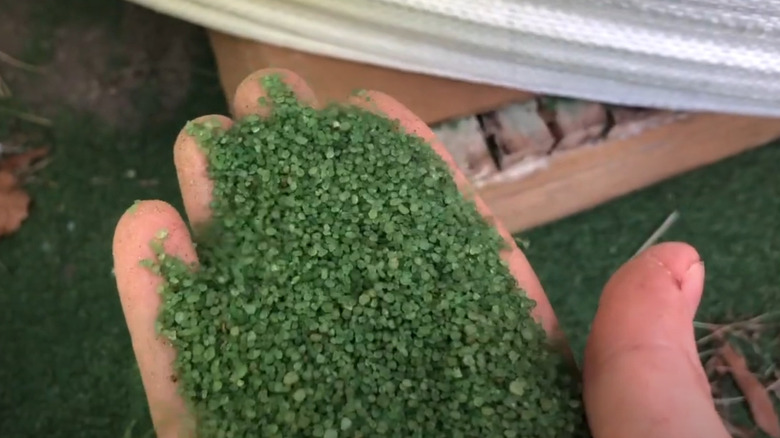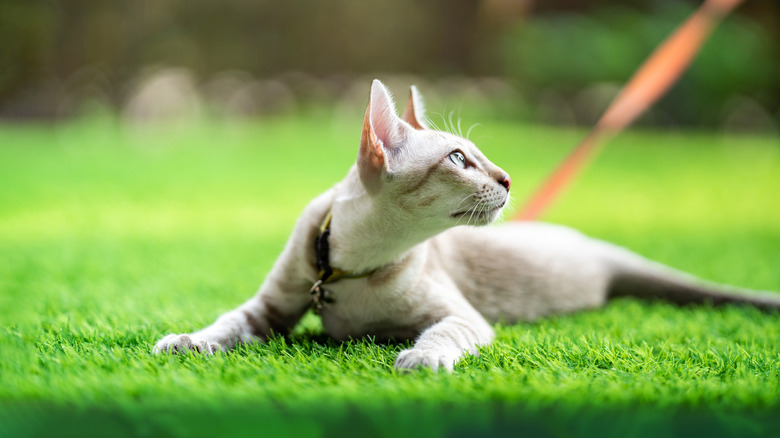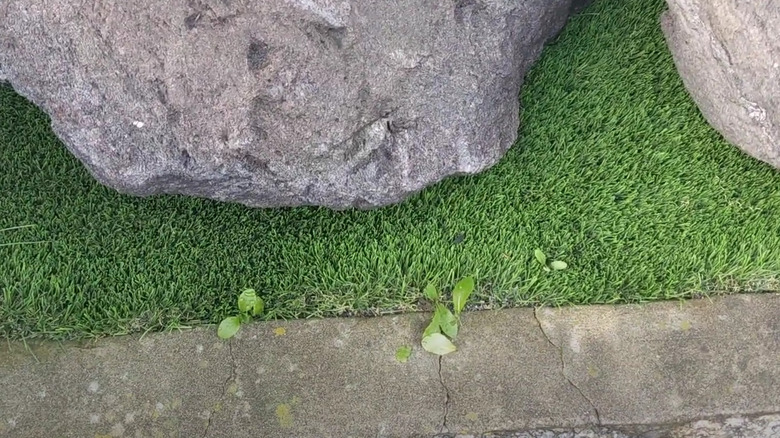10 Hidden Downsides To Artificial Turf You Didn't Know About
Anyone who's ever looked into installing artificial turf in their yard has likely come across the same situation. Most articles written about the advantages of synthetic grass are published by the manufacturers of those products. While artificial turf is often advertised as the solution to common complaints of natural lawns, companies often fail to mention the honest downsides of these products. The truth is that there are pros and cons of installing artificial grass on your property, just like there are with most major purchases.
Below are eleven hidden downsides to installing artificial turf that have been commonly overlooked over the years. Some issues have workarounds and potential solutions, while others can't be changed, as it's just the nature of the synthetic material itself. So, learn about the issues homeowners should know before investing in manufactured materials over organic plant growth. This may make you realize why artificial grass isn't the best option for your lawn or the planet.
DIY artificial turf installation is only feasible for small areas
Laying your own artificial turf has one major similarity to living sod — the smaller the area, the easier it is to lay. It can take up to three days for a professional crew to install 1,000 square feet of turf. As a layperson, you should plan to take even longer. That could be a lot of labor to account for in addition to your day job and other everyday obligations. Such a large undertaking may make the project unfeasible for many homeowners and families.
Keep in mind that installation is not just laying down the artificial turf. It's a multi-step process that involves removing the previous lawn, leveling the land, laying down a base layer, installing the border, laying the artificial turf, and finishing the job with infill.
Laying artificial turf yourself may only be doable if you're covering a small portion of your yard, like a mini pet area or bug-free oasis. If you're intending to cover more than 300 square feet, it's likely best to hire a professional. This requires a bigger budget since professional installations cost between $6 to $22 per square foot on average, depending on the size and location.
Choosing a cool artificial lawn product may not ensure your turf doesn't get hot
Since artificial turf has become more popular and mainstream over the years, there has been new technology to offset one major issue: sunlight makes the synthetic material very hot underfoot. The surface temperature of synthetic turf can soar nearly 90 degrees Fahrenheit higher than that of natural grass. On a typical 80-ish degree summer day, turf's average surface temperature can hover just above 150 degrees. However, the surface temperature of some synthetic turf has been recorded as high as 200 degrees.
So, despite the innovation of cooling infills and new turf yarn technology, turf is still bound to get hot during the summer, especially when the sun is shining brightly. For example, Coolplus technology from Titan Turf promises to reduce the turf's temperature by 20% to 25%. That is a significant number, but it may not be enough of a decrease to prevent issues. Neuroscientist Kathleen Michels tells the National Recreation and Park Association, "Any temperature over 120 degrees Fahrenheit can cause skin burns with skin contact in two seconds."
Keep in mind that cooling tech isn't the only way to keep plastic turf from getting painfully hot. Ensure areas of the lawn are shaded with trees, nearby buildings, canopies, and other installations. Water is also a huge asset. Hose down turf with a cooling infill before letting adults, kids, or pets walk on it as this tech is designed to cool by transpiring water. There are also misting systems like the HomeNote Misting Cooling System or LandGarden Outdoor Misting Fan Kit that can help cool parts of your lawn without you having to unravel an entire hose just to enjoy the outdoors.
Artificial turf recycling isn't wide spread
One of the biggest turnoffs of artificial turf is that it isn't a natural, earth-friendly material, as it's often made of nylon, polyethylene, or polypropylene formulas. Some turf companies are quick to downplay their unnatural product by claiming you can recycle it at the end of its lifecycle. However, PEER Science Policy Director Kyla Bennett stated that this is essentially a lie in a 2022 press release, saying, "Artificial turf makers and vendors use recycling claims as a promotional ploy to portray this product as an environmentally responsible alternative to traditional grass fields — but it is not. The recycling claim for turf is illegal greenwashing." This accusation leads to curiosity about whether plastic lawns are even worse than we think.
On the other hand, there are also innovations in this area. For example, there's a pilot program in California looking to process old sports field turf back to original materials that can be used again. There's also a business that will haul away and coordinate the reuse of still-usable turf from sports fields and events facilities. And, an Italian company is aiming to bring machinery to the States that will make turf recycling much more efficient. So, while these initiatives are currently restricted to sports field turf, more options could arise in the future for homeowners.
Artificial turf manufacturing has some environmental downsides
One of the biggest selling points behind artificial lawns is that they save water. In fact, the University of Arizona estimates that every square foot of synthetic lawn saves about 55 gallons of water annually compared to natural grass. All of these things may be the case, but there are more environmental factors to consider besides water conservation. What these companies often fail to mention is that manufacturing their products increases greenhouse gas emissions and uses large amounts of energy.
Keep in mind that artificial turf does have some small environmental benefits. It still needs some water for cleaning purposes, but it uses far less than traditional lawns. It also reduces the need for chemical-laden fertilizers and pesticides and lessens emissions from gas-powered lawn equipment. However, there are other ways to address these issues without introducing the environmental consequences of artificial turf. There are natural remedies for eliminating pests and weeds from lawns, and natural compost can feed hungry plants. Plus, electric push mowers are steadily rising in popularity, eliminating the need for polluting gas-powered machinery.
Synthetic lawn warranties can be misleading
Companies may advertise 15-year warranties to indicate they have faith that their products will last but be wary of the terms. Many of these warranties feature coverage that decreases over time. For example, some companies will drop the warranty coverage to just 50% after the first 8 years, then down to 25% after 12. These warranties can also exclude damage from color changes, sun damage, and a change of texture, all of which can be natural factors in artificial turf's degradation before the 20-year mark.
Bearing this in mind, consider whether an artificial lawn may or may not be right for your lifestyle. If you're a homeowner who doesn't spend much time outside, doesn't have any playful children or pets, and has a well-shaded yard, your lawn may hold up for longer. Essentially, don't use the warranty as an indicator of when you will need to replace your artificial grass, rather you should listen to anecdotal evidence and what others have experienced.
The chemical concerns around artificial turf aren't over
Consumers should also know that there are no federal requirements for safety testing synthetic turf products.The initial concern with synthetic playground turf, like artificial grass, was that it was crafted from recycled tire rubber. The tires contained PFAS, also known as the forever chemicals, and lead, which is unsafe when children and adults are constantly exposed to them. Even though some artificial companies avoid using rubber for their infill, they now use silica or other materials that have their own lists of complications. Envirofill is a commonly advertised feature of popular synthetic grass companies that's made of silica and touts itself as "naturally occurring sand". Despite the all-natural image being portrayed, silica sand can be inhaled and cause lung damage, especially as it wears down and microscopic pieces break off over time.
This may not be a big concern for you if you aren't active on your lawn. It's mostly an issue for athletes and children who wear out the lawn with physical activity, thereby exposing themselves to the chemicals in these products. Future advancements could eliminate the need for forever chemicals or lung-damaging silica in artificial turf. There's no saying what the future holds, but for now, homeowners should be aware that there's much controversy over the subject between corporations and health institutions.
Artificial turf isn't as pet-friendly as you may hope
One of the latest trends in the artificial turf industry is making "pet-friendly" products. One selling point for Smart Turf is that it features with Microban antimicrobial technology to inhibit bacteria and mold growth. It's designed to reduce odors and provide a safe environment for pets since it doesn't need the insecticides and pesticides that are needed for natural grass. However, just because it isn't real grass doesn't mean you can skip routine cleanup. Seeing as this turf is meant to be your dog or cat's yard, it's natural that they go to the bathroom in it. Unless you're cleaning it regularly, the pet waste is sitting on the plastic with no soil to decompose into, potentially leading to foul smells despite artificial turf companies' claims.
A common consensus among pet owners is that it isn't as great as it seems. People claim that it smells, gets too hot, and requires a lot of maintenance to keep up with your pets' antics. To reduce the smell, you can install drainage areas and lay down pads in designated areas to encourage pets to go in those places instead of on the artificial grass, leading to less cleanup. However, incorporating these tactics highly depends on how trainable your pets are and if you have the budget or knowledge to install drains.
Artificial turf isn't maintenance-free
If you're trying to figure out which is a better lawn option for your space, artificial turf or natural grass, maintenance requirements might be a pivotal consideration. Artificial turf has a reputation of requiring zero maintenance, but this is not entirely accurate. It's a plastic product that's outside in the sun and rain, and it's inevitably going to get dirty, even with antimicrobial technology. Dirt, debris, and grime will build up even with minimal use, and you'll need to know how to clean artificial grass with a hose on occasion. Debris, like leaves and branches from other yards, can also get caught in the synthetic material. If you don't have time to clean yourself, there are professional services out there. These services don't come cheap, averaging about $0.25 to $0.35 per square foot, which could quickly add up in a large yard. If spots need to be repaired or replaced, that could cost another $2 to $10 a square foot.
The infill levels of turf must also be assessed to make sure they're maintained. The manufacturer and installer may also have specific guidelines that you should follow. However, it's likely that you will need to have new infill added to your turf at some point. Often, turf rolls must be sliced open and pulled back to replace the old infill. It then takes brushing in new infill, possibly mixing it with some of the old infill, before putting the lawn back together. The average infill replacement cost is about $0.30 to $1.75 a square foot, depending on a number of factors.
You still need to weed an artificial lawn
Seeing as synthetic turf is laid above an equally synthetic infill, you would think that your weeding days are over. Unfortunately, weeds seem to always find a way. The infill subdues most of them, but stragglers still manage to germinate on the topside of the turf or in tiny gaps beneath it and on the edges. Ironically, if weeds invade an artificial lawn, they are treated in a similar fashion to how you would treat living grass. Although artificial grass companies advertise not needing pesticides, chemical weedkillers are a solution that some recommend.
Fortunately, you can lay a weed barrier, like ECOgardener Premium Landscape Fabric, before putting down artificial turf as an extra line of defense. However, this may not be the best course of action if you have pets. The fabric that suppresses weeds also retains odors, meaning pet pee could linger beneath your artificial turf. This also doesn't stop new weed seeds from sprouting on top of the artificial grass.
Artificial lawns can develop mold, algae, and fungi
The myth that synthetic turf is free of some of the common afflictions of living grass has been proven wrong. Artificial lawns are still outdoors and prone to algae, fungi, mold, and mildew growth. It's especially common in unused areas with shade, as they're undisturbed, maintain more reasonable temperatures, and may have morning condensation on a regular basis. Unfortunately, preventing these growths contradicts solutions to other artificial grass problems, like using water to keep it cool. It's recommended to trim back nearby trees and gardens so sunlight strikes potential mold and mildew spores. This kills off spores but also may make artificial turf too hot to bear. Another option is to install proper drainage with a perforated backing, though this creates points of weakness that weeds can take advantage of.
Other advice is simply common sense. It's wise to keep up with maintenance and clean up pet messes, organic matter, and other spills to keep bacteria to a minimum. Examine the turf routinely just to ensure nothing damaging has started to grow. A solution of hydrogen peroxide can take care of growth before it spreads, but it's important to stay vigilant as it's easier to control mold, mildew, and fungus in the early stages.
